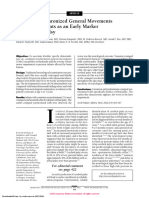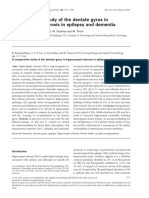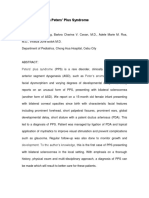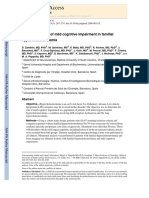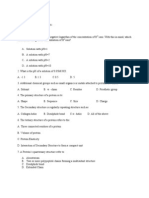Frontotemporal Dementia Linked To Chromosome 3: A C D e B B G A A F F B B
Frontotemporal Dementia Linked To Chromosome 3: A C D e B B G A A F F B B
Uploaded by
kprbioCopyright:
Available Formats
Frontotemporal Dementia Linked To Chromosome 3: A C D e B B G A A F F B B
Frontotemporal Dementia Linked To Chromosome 3: A C D e B B G A A F F B B
Uploaded by
kprbioOriginal Title
Copyright
Available Formats
Share this document
Did you find this document useful?
Is this content inappropriate?
Copyright:
Available Formats
Frontotemporal Dementia Linked To Chromosome 3: A C D e B B G A A F F B B
Frontotemporal Dementia Linked To Chromosome 3: A C D e B B G A A F F B B
Uploaded by
kprbioCopyright:
Available Formats
Dement Geriatr Cogn Disord 2004;17:274–276
DOI: 10.1159/000077153
Frontotemporal Dementia Linked to
Chromosome 3
Jerry Brown a Susanne Gydesen c Peter Johannsen d Anders Gade e
Gaia Skibinski b Lisa Chakrabarti b Arne Brun g Maria Spillantini a
Despina Yancopoulou a Tove Thusgaard f Asger Sorensen f
Elizabeth Fisher b John Collinge b FReJA (Frontotemporal Dementia
Research in Jutland Association)
a Department of Neurology, Addenbrooke’s Hospital, Cambridge, b MRC Prion Unit, Institute of Neurology, London,
UK; c Department of Psychiatry, Central Hospital, Holbaek, d PET Centre, Department of Neurology,
Aarhus University Hospitals, Aarhus, e Department of Psychology, University of Copenhagen, Rigshospitalet,
f Institute of Medical Genetics, Panum Institute, Copenhagen, Denmark; g Department of Pathology,
University Hospital of Lund, Lund, Sweden
Key Words family has been studied for over 15 years by Dr. Susanne
Frontotemporal dementia W Chromosome 3 Gydesen and more recently by our collaboration – FreJA
(Frontotemporal Dementia Research in Jutland Associa-
tion). The family was first described by Dr. Gydesen et al.
Abstract in 1987 [1]. Information about the linkage to chromo-
A large pedigree with autosomal dominant frontotempo- some 3 was published in 1995 [2] and full clinical and
ral dementia has been identified. Positional cloning has pathological details and references to all earlier works on
linked the disease gene to the pericentromeric region of this topic issued in Neurology were published in 2002 [3]
chromosome 3. Clinical, neuropsychological, imaging, (with a supplement on the journal web site).
pathological and molecular genetic data are presented.
The genetic mutation responsible for the disease has not
been identified. The Family
Copyright © 2004 S. Karger AG, Basel
The proband was a farmer’s wife who was born in
1876. She had 12 children who survived to adulthood.
Introduction She developed dementia at the age of 56 years and died in
1948 at the age of 68 years. Eight of her children devel-
We report on the results of a multinational, multidisci- oped dementia and 1 further individual died in a traffic
plinary study of a novel form of frontotemporal dementia accident at the typical age of onset of this disease. He had
(FTD) defined by its clinical, neuropsychological, imag- passed the disease onto his children. Therefore, he must
ing and pathological features and its linkage to the peri- have carried the disease gene. It is possible that his acci-
centromeric region of chromosome 3 (FTD-3). dent was related to early dementia.
FTD-3 has been described in a single pedigree, which Twenty-six individuals in 4 generations developed de-
originates and resides in western Jutland, Denmark. The mentia. There was male to male transmission and the pat-
© 2004 S. Karger AG, Basel Dr. J.M. Brown
ABC 1420–8008/04/0174–0274$21.00/0 Department of Neurology, Addenbrooke’s Hospital
Fax + 41 61 306 12 34 Hills Road, Cambridge CB2 2QQ (UK)
E-Mail karger@karger.ch Accessible online at: Tel. +44 1223 217909, Fax +44 1223 217554
www.karger.com www.karger.com/dem E-Mail jmb75@medschl.cam.ac.uk
tern of inheritance was autosomal dominant. The age of Nineteen affected individuals have had a CT brain
onset varied between 46 and 65 years and the duration of scan. Four out of 5 with symptoms at the time of scanning
the disease between 3 and 21 years. The mean age at dis- showed global atrophy. One of the 14 without symptoms
ease onset was 57 years. In 1995 [2], we published evi- had atrophy; she developed symptoms of the disease 15
dence that there was anticipation of the age of onset with years later. On CT brain scans, the atrophy has a general-
paternal transmission. However, recent paternally inher- ized pattern with both cortical and central atrophy having
ited cases have had a later onset than their father, casting secondary enlargement of the lateral ventricles. There is
doubt on our earlier observation. no clear frontal preponderance. MRI scans have been per-
There is a trend to increasing age of onset in more formed in 2 cases showing a similar pattern of atrophy
recent decades, suggesting the possibility of a protective with some frontal preponderance and some white matter
factor, which is likely to be environmental. However, the changes in 1 individual.
trend is not statistically significant [FReJA, unpubl. Positron emission tomography (PET) scanning mea-
obs.]. suring quantitative regional cerebral blood flow (rCBF)
with 0–15 water has been performed in 4 affected individ-
uals and 6 first-degree ‘at risk’ individuals. PET CBF
Clinical Characteristics scans of first-degree relatives were all considered to be
within normal limits at the time of scanning. One of the
The clinical phenotype has been uniform, when the healthy first-degree relatives was rescanned 6 years later
large number of cases is considered. The disease starts after she had developed the disease. The new scan showed
with a change in behaviour and personality. Affected indi- no significant changes in either the absolute CBF values
viduals may become disinhibited or may withdraw and or in the regional distribution of the flow. In the affected
become apathetic. Ritualized behaviour, loss of emotion individuals, PET scanning showed a reduction in the per-
and change in eating habits are common. Some individu- fusion of the frontal, temporal and parietal lobes, without
als develop dyscalculia, suggesting a parietal lobe involve- clear frontal preponderance. Normal flow measurements
ment, but no individuals have early features such as were obtained in the primary visual cortex, thalami, basal
route-finding problems or visuospatial problems. The dis- ganglia and cerebellum. A visual comparison of the scans
ease is generally slowly progressive and the patient devel- between the 4 patients indicates more pronounced defi-
ops dynamic aphasia, which typically progresses to abbre- cits with lower rCBF values in the more severely affected
viated words and then mutism. patients.
Physical signs are absent in the early stages of the dis-
ease. After 4 or more years into the illness, several indi-
viduals have developed a striking motor syndrome. Many Pathology and Genetics
of these individuals have been exposed to neuroleptic
drugs, but the syndrome continues to progress years after Pathological examination of the brain has been per-
the neuroleptic drugs have been stopped. They develop an formed in 6 individuals, but only 3 of these brains are still
asymmetric akinetic rigid syndrome with arm and gait available for study. On external examination and slices,
dystonia and pyramidal signs. there is mild generalized, but mainly frontal, cortical atro-
A retrospective structured interview of carers shows phy with neuronal loss and gliosis, affecting particularly
close similarity in symptoms to other cases of FTD [4] the upper half of the cortex. Some brains show mainly
and clear differences to Alzheimer’s disease. The results frontal white matter attenuation with mild gliosis and loss
of these interviews indicate early behavioural and person- of myelin. There are no inclusion bodies and staining for
ality change with preservation of episodic memory and beta amyloid and prion protein is negative. There is some
topographical orientation, as well as a lack of insight and tau deposition, more marked in individual 11,12 who had
empathy. a very protracted disease course.
More detailed recent studies on affected individuals Molecular genetic studies published in 1995 [2] dem-
show very widespread cognitive deficits with preservation onstrated a linkage of the disease gene in this family to the
of memory and visuospatial skills. Monitoring of individ- pericentromeric region of chromosome 3. Repeat analyses
uals using serial Mini-Mental State Examinations reveals of newly affected individuals have confirmed the linkage
relatively good scores early in the illness and then a sharp to this region. Extensive sequencing of candidate genes in
decline with worsening dynamic aphasia. the region has not revealed a pathogenic mutation. Earlier
Frontotemporal Dementia Linked to Dement Geriatr Cogn Disord 2004;17:274–276 275
Chromosome 3
studies suggested that there was anticipation of the age of Southern blot analysis is being used to look for large
onset with paternal inheritance, which led to an extensive genetic deletions and fluorescent in situ hybridization
search for a trinucleotide expansion mutation; however, technology is being employed to identify larger chromo-
none has been located. somal rearrangements.
References 1 Gydesen S, Hagen S, Klinken L, Abelskov J, 3 Gydesen S, Brown J, Brun A, Chakrabarti L,
Sorensen SA: Neuropsychiatric studies in a Gade A, Johannsen P, Rossor M, Thusgaard T,
family with presenile dementia different from Grove A, Yancopoulou D, Spillantini MG,
Alzheimer and Pick disease. Acta Psychiatr Fisher E, Collinge J, Sorensen SA: Chromo-
Scand 1987;76:276–284. some 3 linked frontotemporal dementia (FTD-
2 Brown J, Ashworth A, Gydesen S, Sorensen A, 3). Neurology 2002;59:1585–1594.
Rossor M, Hardy J, Collinge J: Familial non- 4 Brun A, Englund B, Gustafson L, Passant U,
specific dementia maps to chromosome 3. Mann DMA, Neary D, Snowden JS: Consensus
Hum Mol Genet 1995;4:1625–1628. statement – Clinical and neuropathological cri-
teria for frontotemporal dementia. J Neurol
Neurosurg Psychiatry 1994;57:416–418.
276 Dement Geriatr Cogn Disord 2004;17:274–276 Brown et al.
Copyright: S. Karger AG, Basel 2004. Reproduced with the permission of S. Karger AG, Basel. Further
reproduction or distribution (electronic or otherwise) is prohibited without permission from the copyright
holder.
You might also like
- Bio 137 Lab ManualDocument185 pagesBio 137 Lab ManualReedNo ratings yet
- Family History of Alzheimer's Disease and Cortical Thickness in Patients With DementiaDocument7 pagesFamily History of Alzheimer's Disease and Cortical Thickness in Patients With DementiaMarcos Josue Costa DiasNo ratings yet
- 1 s2.0 S0140673617312874 MainDocument15 pages1 s2.0 S0140673617312874 MainmeryemNo ratings yet
- Parkinson Disease, Dementia, and Alzheimer Disease - Clinicopathological CorrelationsDocument7 pagesParkinson Disease, Dementia, and Alzheimer Disease - Clinicopathological Correlationsfilipa.sofia.custodioNo ratings yet
- Clinicopathological Case Conference:: A 17 Year Old With Progressive Gait Difficulty and A Complex Family HistoryDocument3 pagesClinicopathological Case Conference:: A 17 Year Old With Progressive Gait Difficulty and A Complex Family HistoryChoi SpeaksNo ratings yet
- Aicardi-Goutie'res Syndrome: Neuroradiologic Findings and Follow-UpDocument6 pagesAicardi-Goutie'res Syndrome: Neuroradiologic Findings and Follow-UpclaypotgoldNo ratings yet
- Prion Disease: Kelly J. Baldwin, MD Cynthia M. Correll, MDDocument12 pagesPrion Disease: Kelly J. Baldwin, MD Cynthia M. Correll, MDMerari Lugo Ocaña100% (1)
- Cariotipo X Fragil y 47, XXX PDFDocument6 pagesCariotipo X Fragil y 47, XXX PDFLìzeth RamìrezNo ratings yet
- Adult LeucodystrophyDocument12 pagesAdult LeucodystrophylauraalvisNo ratings yet
- KaleidoscopeDocument2 pagesKaleidoscopeKasep PisanNo ratings yet
- Total Agenesis of The Corpus Callosum in A Patient With Childhood-Onset SchizophreniaDocument4 pagesTotal Agenesis of The Corpus Callosum in A Patient With Childhood-Onset SchizophreniaBhagyaraj JeevangiNo ratings yet
- Ajmg A 34257 PDFDocument3 pagesAjmg A 34257 PDFdtf1007No ratings yet
- Acta Neuro Scandinavica - 2022 - Modulo 1Document12 pagesActa Neuro Scandinavica - 2022 - Modulo 1marianacampanicoNo ratings yet
- Background: The Genetic of AnticipationDocument3 pagesBackground: The Genetic of AnticipationAh LynNo ratings yet
- Cla Eys 1997Document6 pagesCla Eys 1997jahfdfgsdjad asdhsajhajdkNo ratings yet
- Marinesco-Sjo Gren Syndrome - 2013Document5 pagesMarinesco-Sjo Gren Syndrome - 2013Irfan RazaNo ratings yet
- New Genes Causing Hereditary Parkinson 'S Disease or ParkinsonismDocument11 pagesNew Genes Causing Hereditary Parkinson 'S Disease or ParkinsonismAngélicaNo ratings yet
- Le Mire 2004Document2 pagesLe Mire 2004Fapuw ParawansaNo ratings yet
- Autism Spectrum Disorders and Underlying Brain Pathology in CHARGE AssociationDocument11 pagesAutism Spectrum Disorders and Underlying Brain Pathology in CHARGE AssociationLuwinda SariNo ratings yet
- Pathophysiology of Alzheimer's Disease: Neuroimaging Clinics of North America December 2005Document28 pagesPathophysiology of Alzheimer's Disease: Neuroimaging Clinics of North America December 2005AnisNo ratings yet
- Evidence For Human Transmission of Amyloid-Cerebral Amyloid AngiopathyDocument36 pagesEvidence For Human Transmission of Amyloid-Cerebral Amyloid Angiopathy13_06_08No ratings yet
- 52 Tripathy EtalDocument5 pages52 Tripathy EtaleditorijmrhsNo ratings yet
- ALSDocument14 pagesALSZé CunhaNo ratings yet
- Letter To The Editor: Midline Field Defects and Hirschsprung DiseaseDocument2 pagesLetter To The Editor: Midline Field Defects and Hirschsprung DiseaseAraNo ratings yet
- Prevalence of Tourette Syndrome and Chronic Tics I PDFDocument16 pagesPrevalence of Tourette Syndrome and Chronic Tics I PDFFitriazneNo ratings yet
- 1 - Investigação Genética Das Demências Na Prática ClínicaDocument6 pages1 - Investigação Genética Das Demências Na Prática Clínicaveidamororo17No ratings yet
- Successful Growth Hormone Therapy in Cornelia de Lange SyndromeDocument5 pagesSuccessful Growth Hormone Therapy in Cornelia de Lange SyndromeDenny SigarlakiNo ratings yet
- Jact 03 I 3 P 247Document2 pagesJact 03 I 3 P 247Saad MotawéaNo ratings yet
- CS Ferrari2002Document8 pagesCS Ferrari2002Cindy MartínezNo ratings yet
- Alzheimer 4 PDFDocument19 pagesAlzheimer 4 PDFMaria Fernanda RomeroNo ratings yet
- ! - A Comparative Study of The Dentate Gyrus in Hippocampal Sclerosis in Epilepsy and Dementia (2014)Document14 pages! - A Comparative Study of The Dentate Gyrus in Hippocampal Sclerosis in Epilepsy and Dementia (2014)Apróné Török IbolyaNo ratings yet
- A Clinical Tool For Predicting Survival in ALSDocument8 pagesA Clinical Tool For Predicting Survival in ALSFanel PutraNo ratings yet
- SJDBVDocument6 pagesSJDBVadamilzaryNo ratings yet
- 2018-Alexander DiseaseDocument8 pages2018-Alexander DiseasePatricio MerinoNo ratings yet
- Pelizaeus-Merzbacher Disease in Patients With Molecularly Confirmed DiagnosisDocument7 pagesPelizaeus-Merzbacher Disease in Patients With Molecularly Confirmed Diagnosistptjqd96j6No ratings yet
- 1 s2.0 S1071909198800077 MainDocument8 pages1 s2.0 S1071909198800077 MainamandaribeirouNo ratings yet
- A Critical Review of Genetic Studies ofDocument5 pagesA Critical Review of Genetic Studies ofdrsam80059No ratings yet
- Pisa Syndrome Source Clin Neuropharmacol SO 2015 Jul Aug 38 4 135 40 (PMIDT26166239)Document6 pagesPisa Syndrome Source Clin Neuropharmacol SO 2015 Jul Aug 38 4 135 40 (PMIDT26166239)dai shujuanNo ratings yet
- Ashfaq Redddy RHD 2007 Paper PDFDocument4 pagesAshfaq Redddy RHD 2007 Paper PDFAmàr AqmarNo ratings yet
- American Academy of Neurology Key PointsDocument193 pagesAmerican Academy of Neurology Key Pointszayat13No ratings yet
- Er 2017-00212Document35 pagesEr 2017-00212maria claraNo ratings yet
- Miller 2015Document12 pagesMiller 2015José HuilcaNo ratings yet
- Fahr's Disease 26, SoldierDocument7 pagesFahr's Disease 26, Soldiermercyzhimo77No ratings yet
- Case Report FinalDocument14 pagesCase Report FinalAaron Lemuel OngNo ratings yet
- Genetic Counseling For Prion Disease Updates and Best - 2022 - Genetics in MediDocument11 pagesGenetic Counseling For Prion Disease Updates and Best - 2022 - Genetics in Medironaldquezada038No ratings yet
- 81 179 1 SMDocument5 pages81 179 1 SMconcozNo ratings yet
- Brain 2014 Yu Brain Awu239Document5 pagesBrain 2014 Yu Brain Awu239Angeles RbNo ratings yet
- Acute Brain MRIDocument7 pagesAcute Brain MRIRobin SianiparNo ratings yet
- Alzheimer Iatrogénico. Nature. 2024Document17 pagesAlzheimer Iatrogénico. Nature. 2024Jhampier RaigosaNo ratings yet
- Full Text 01Document8 pagesFull Text 01Zunaira AmberNo ratings yet
- A Case of D-Bifunctionnal Protein DeficiencyDocument5 pagesA Case of D-Bifunctionnal Protein Deficiencyalouimouadh150No ratings yet
- Pathophysiology of Alzheimer's Disease: Neuroimaging Clinics of North America December 2005Document28 pagesPathophysiology of Alzheimer's Disease: Neuroimaging Clinics of North America December 2005Lutfiani Barkah PNo ratings yet
- Research Paper Alzheimers DiseaseDocument4 pagesResearch Paper Alzheimers Diseaseh03xhmf3100% (1)
- E472 FullDocument17 pagesE472 FullC_DanteNo ratings yet
- Pappolla Familial Hypercholesterolemia and Mild Cognitive ImpairmentDocument13 pagesPappolla Familial Hypercholesterolemia and Mild Cognitive ImpairmentMike Pappolla MD, PhDNo ratings yet
- Phenotypic Spectrum of Costello Syndrome Individuals Harboring The Rare HRAS MutDocument15 pagesPhenotypic Spectrum of Costello Syndrome Individuals Harboring The Rare HRAS MutshefbabeNo ratings yet
- Genética Do Autismo: Genetics of AutismDocument3 pagesGenética Do Autismo: Genetics of Autismonurb90No ratings yet
- A Very Infrequent Association of William-Beuran Syndrome and Tetralogy of FallotDocument3 pagesA Very Infrequent Association of William-Beuran Syndrome and Tetralogy of FallotInternational Journal of Clinical and Biomedical Research (IJCBR)No ratings yet
- 1456 FullDocument7 pages1456 Fulldrmanishmahajan79No ratings yet
- A Statistical Inquiry Into the Nature and Treatment of EpilepsyFrom EverandA Statistical Inquiry Into the Nature and Treatment of EpilepsyNo ratings yet
- Blood BiochemistryDocument124 pagesBlood BiochemistrySohail AhamdNo ratings yet
- Idh1, Idh2 Idh2 1p19q Co-Deletion, IDH1, IDH2, BRAF, EGFR AmplificationDocument12 pagesIdh1, Idh2 Idh2 1p19q Co-Deletion, IDH1, IDH2, BRAF, EGFR AmplificationNirbhay Singh Rathore100% (1)
- Human Endogenous Retroviruses and AIDS Research: Confusion, Consensus, or Science?Document6 pagesHuman Endogenous Retroviruses and AIDS Research: Confusion, Consensus, or Science?DisicienciaNo ratings yet
- Dissertation On Stem CellsDocument8 pagesDissertation On Stem CellsCollegePaperWritingHelpCanada100% (1)
- (Libro) The Role of Biotechnology in Improvement of Livestock Animal Health and Biotechnology-Muhammad Abubakar, Ali Saeed, ODocument151 pages(Libro) The Role of Biotechnology in Improvement of Livestock Animal Health and Biotechnology-Muhammad Abubakar, Ali Saeed, OramsesmuseNo ratings yet
- Biological Membranes and Transport and BiosignalingDocument34 pagesBiological Membranes and Transport and BiosignalingBONAVENTURA ALVINO DESMONDANo ratings yet
- List of Abstracts: Francis BachDocument5 pagesList of Abstracts: Francis BachTDLemonNhNo ratings yet
- Cladogram Lesson PlanDocument5 pagesCladogram Lesson Planapi-665322772No ratings yet
- Biology Gen Inherit LabDocument4 pagesBiology Gen Inherit LabMasOom Si ChuRailNo ratings yet
- SB4 QuestionsDocument6 pagesSB4 Questionshg eagleNo ratings yet
- MitosisDocument21 pagesMitosisChristine PiedadNo ratings yet
- 1st Periodical Test Grade 9Document7 pages1st Periodical Test Grade 9Jay Ronnie PranadaNo ratings yet
- Sri Chaitanya Educational Institutions, India.: Instructions To CandidateDocument2 pagesSri Chaitanya Educational Institutions, India.: Instructions To CandidateLiba Affaf100% (2)
- Test-1 IntroductionDocument4 pagesTest-1 IntroductionAli AzlanNo ratings yet
- A2.3 Viruses (AHL) NotesDocument15 pagesA2.3 Viruses (AHL) NotesRizwana NaureenNo ratings yet
- 10 1016@j Antiviral 2013 01 007 PDFDocument27 pages10 1016@j Antiviral 2013 01 007 PDFChristian QuijiaNo ratings yet
- MSC QuizDocument6 pagesMSC QuizLokesh WaranNo ratings yet
- 28.diffuse Idiopathic Skeletal Hyperostosis - Clinical Features and Pathogenic MechanismsDocument10 pages28.diffuse Idiopathic Skeletal Hyperostosis - Clinical Features and Pathogenic Mechanismscanhtung1989No ratings yet
- Peran Perawat Mencegah Penularan HIV Dan Merawat ODHA XXDocument110 pagesPeran Perawat Mencegah Penularan HIV Dan Merawat ODHA XXApel HijauNo ratings yet
- #13 Digestive System - OllanasDocument9 pages#13 Digestive System - OllanasKirsten AletheaNo ratings yet
- Plant Hormone Csir Net Notes Merit Life Sciences 85560092620 To JoinDocument18 pagesPlant Hormone Csir Net Notes Merit Life Sciences 85560092620 To Joinmerit tutorials com NET JRF JAM TUTORIALSNo ratings yet
- Cells of Immune System Notes 2Document70 pagesCells of Immune System Notes 2Sudeeksha Ravikoti100% (1)
- The Human Genome ProjectDocument13 pagesThe Human Genome ProjectkkkkNo ratings yet
- Chapter 5 Molecular Diffusion in Biological Solutions & GelsDocument14 pagesChapter 5 Molecular Diffusion in Biological Solutions & Gelsrushdi100% (2)
- Han DKK., 2012 PDFDocument14 pagesHan DKK., 2012 PDFChichi FauziyahNo ratings yet
- VocBridgecourseRevisedSyllabus 2017-18 PDFDocument149 pagesVocBridgecourseRevisedSyllabus 2017-18 PDFsingoj.bhargava charyNo ratings yet
- Phage Therapy - PresentationDocument16 pagesPhage Therapy - PresentationImen Brz100% (1)
- Surgical Pathology - Diseases of The Central Nervous System 401 - Dr. Baby Lynne Asuncion - October 20-28, 2014Document10 pagesSurgical Pathology - Diseases of The Central Nervous System 401 - Dr. Baby Lynne Asuncion - October 20-28, 2014atb_phNo ratings yet
- Earth and Life Science Q2 LP 2Document3 pagesEarth and Life Science Q2 LP 2Jhoana OrenseNo ratings yet




























